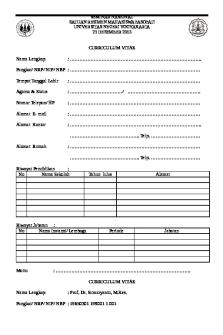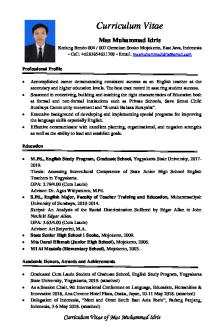Resume, CV, Biodata PDF

| Title | Resume, CV, Biodata |
|---|---|
| Course | Communication Skills |
| Institution | Panjab University |
| Pages | 3 |
| File Size | 104.2 KB |
| File Type | |
| Total Downloads | 111 |
| Total Views | 144 |
Summary
This document covers topics under resume, CV and biodata....
Description
Difference between a Resume, CV and Biodata It is seen that most of the freshers were confused about the term Resume, Curriculum Vitae (CV), and BioData. As they need to forward to apply for a job or corporate ask them to send or submit any of the mentioned document. In this article, we focused on differentiating between all of them. RESUME A resume is a French word meaning “summary”. A resume is ideally a summary of one’s which include education, skills, and employment when applying for a new job. A resume does not list out all details of a profile, but only some specific skills customized to the target job profile. It thus is usually 1 or at the max 2 pages long. A resume is usually written in the third person to give it an objective and formal tone. Some key points while writing a Resume 1. Audience: A general audience; employers who hire for a wide variety of positions 2. Goal: Represent the skills and experience necessary to succeed in the position from all areas—job-related, volunteer, and extracurricular activities 3. Length: 1 to 2 pages (Preferably 1Page) 4. Essential Information: Only those skills and experiences which are relevant to the position you are seeking 5. References: Not included A resume is more applicable for entry, middle and senior level job where experiences and skill sets get more preference than academic qualifications CURRICULUM VITAE (CV) A Curriculum Vitae is a Latin word meaning “course of life” . It is more detailed than a resume, generally 2 to 3 pages, or even longer as per the requirement. A C.V. lists out every skill, all the jobs and positions held, degrees, professional affiliations the applicant has acquired, and in chronological order. A C.V. is used to highlight the general talent of the candidate rather than specific skills for a specific position.
Some key points while writing a C. V. 1. Stands for Curriculum Vitae 2. Audience: Employers from companies related to your field of study as you apply for jobs or internships. 3. Goal: Demonstrate your academic achievements and scholarly potential, experiences and skills 4. Length: At least 1 page 5. Essential Information: Experiences, Technical proficiency, Achievements, Positions of responsibilities, extracurricular 6. References: Included A CV is a preferred option for people looking for a career change, and those applying for academic positions.
“COURSE
OF
ONE’S
LIFE”;
EMPHASIS
ON
COMPLETE
DETAILS
OF
ACHIEVEMENTS ; LONGER THAN RESUME; PREFERRED FOR CAREER CHANGE AND ALSO FRESH GRADUATES.
BIODATA A Biodata is the short form for Biographical Data and is an archaic terminology for Resume or C.V. In a biodata, the focus is on personal particulars like date of birth, gender, religion, race, nationality, residence, marital status, and the like. A chronological listing of education and experience comes after that. A biodata is more like of a biography of a person i.e. one’s work and life experiences. Here the focus is given to the personal attributes such as name, age, height, weight, sex, etc that describes the person best. It is mainly used for applying for government and defense jobs or for any academic grants. It is also used for making profiles on matrimony websites. The word is commonly used in India.
“BIOGRAPHICAL INFORMATION”; FOCUS ON PERSONAL ATTRIBUTES; USED IN PLACES WHERE INFORMATION IS NEEDED FOR INDIVIDUAL SELECTION.
Please Note that No one in Business will ever ask you for a Bio Data. People who are in academia only ask for your CV. Even it would be extremely illegal in the US–even volunteering information about your nationality, residence, date of birth, religion, race, gender, marital status, etc on an application to school or a job in the US will scare away any and every employer always. There are only formatting differences between Resume and Curricula vitae (CV) — the most obvious of which is that resumes are generally 1 page, maybe 3 pages if you’re a rock star. CVs are exhaustive, 3-6 pages. In the modern world, a resume can list years without months, even skip years. The only “right” or “wrong” is if someone cares. You can make them chronological or sorted by whatever gets you the job. In the art world, your resume can be modern art, a giant Hello Kitty dipped in Jello, and if it works, it works. Curricula vitae have a precise format. You’re partially demonstrating your ability to obey rules about citation rules and font sizes — to care enough to adjust your margins to adjust to each printer....
Similar Free PDFs

Resume, CV, Biodata
- 3 Pages

Supervisor Biodata - Xyx
- 2 Pages

Cv english - cv engels
- 2 Pages

FORMAT BIODATA TA'ARUF
- 4 Pages

Cv library general cv template
- 2 Pages

CV hur man skriver CV
- 2 Pages

Cv - nil
- 4 Pages

Resume
- 2 Pages

CV Pembicara
- 2 Pages

Contoh CV
- 7 Pages

Rizal CV
- 3 Pages

Resume-drama - Resume Templet
- 3 Pages
Popular Institutions
- Tinajero National High School - Annex
- Politeknik Caltex Riau
- Yokohama City University
- SGT University
- University of Al-Qadisiyah
- Divine Word College of Vigan
- Techniek College Rotterdam
- Universidade de Santiago
- Universiti Teknologi MARA Cawangan Johor Kampus Pasir Gudang
- Poltekkes Kemenkes Yogyakarta
- Baguio City National High School
- Colegio san marcos
- preparatoria uno
- Centro de Bachillerato Tecnológico Industrial y de Servicios No. 107
- Dalian Maritime University
- Quang Trung Secondary School
- Colegio Tecnológico en Informática
- Corporación Regional de Educación Superior
- Grupo CEDVA
- Dar Al Uloom University
- Centro de Estudios Preuniversitarios de la Universidad Nacional de Ingeniería
- 上智大学
- Aakash International School, Nuna Majara
- San Felipe Neri Catholic School
- Kang Chiao International School - New Taipei City
- Misamis Occidental National High School
- Institución Educativa Escuela Normal Juan Ladrilleros
- Kolehiyo ng Pantukan
- Batanes State College
- Instituto Continental
- Sekolah Menengah Kejuruan Kesehatan Kaltara (Tarakan)
- Colegio de La Inmaculada Concepcion - Cebu



